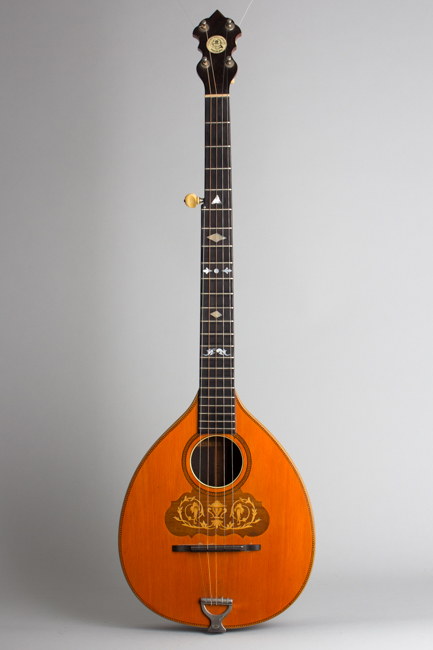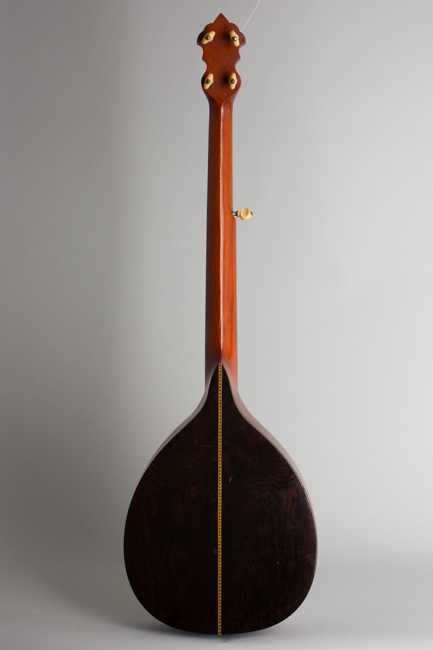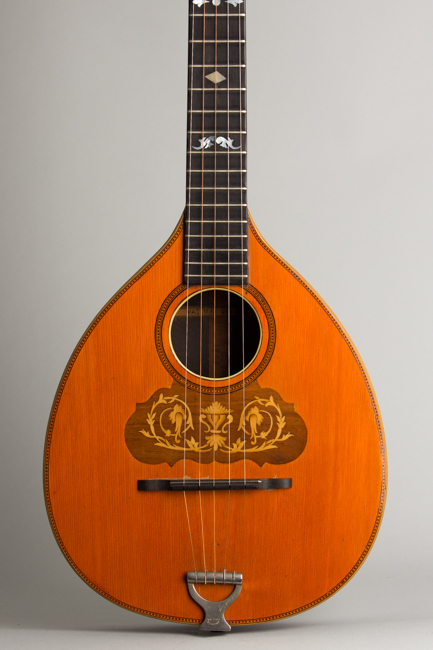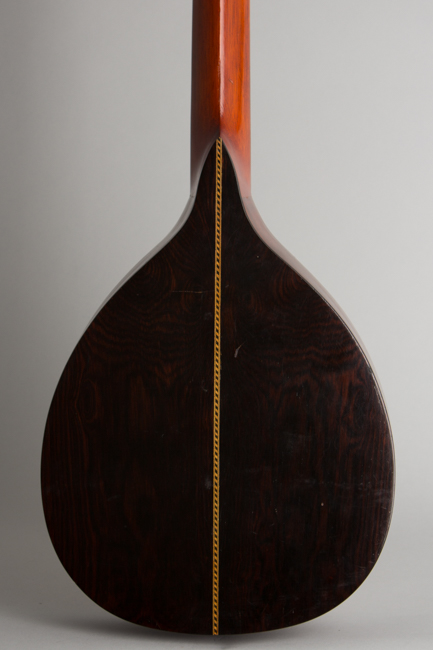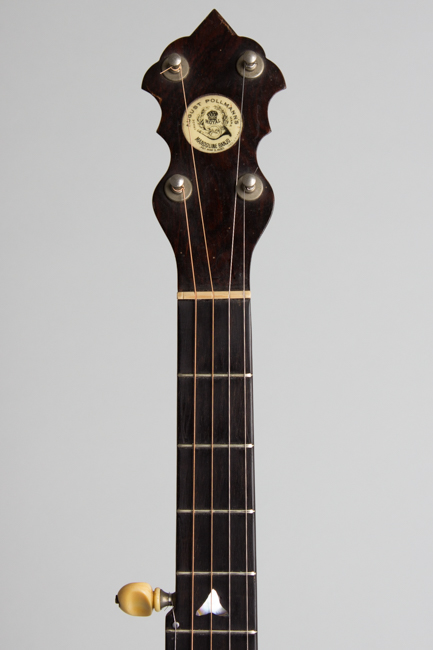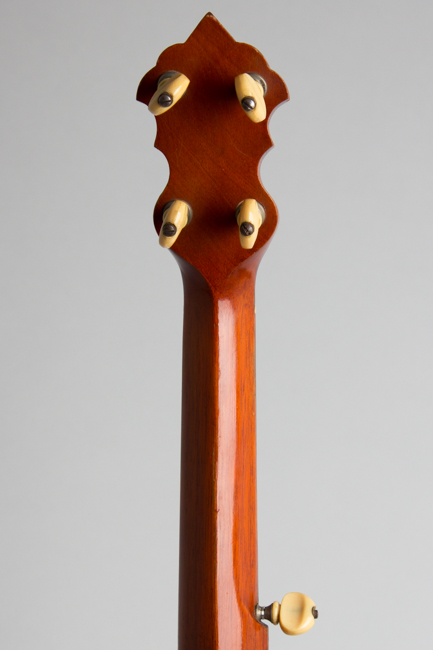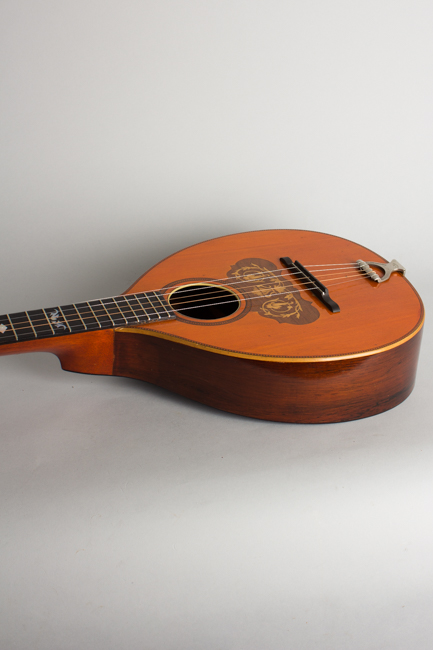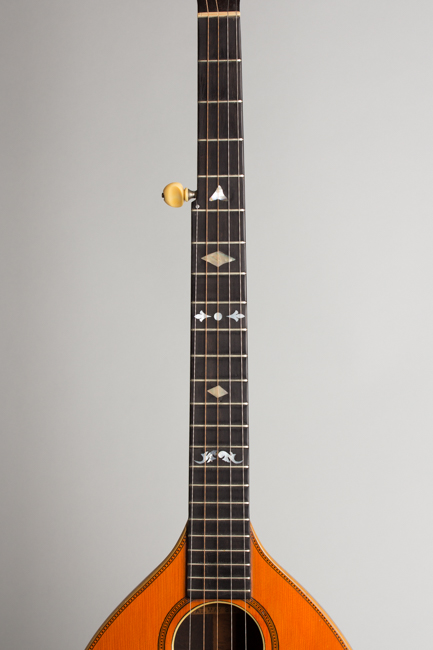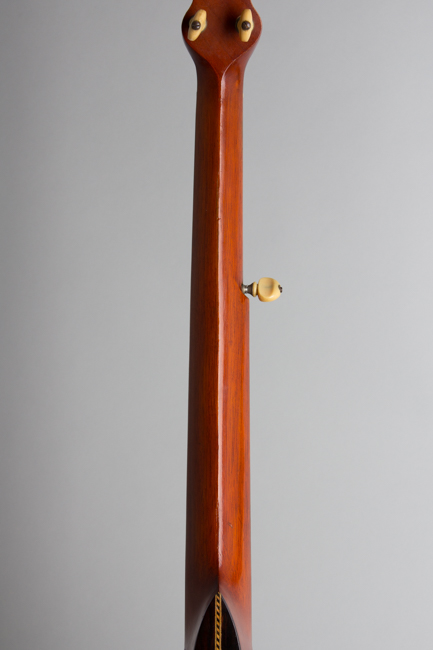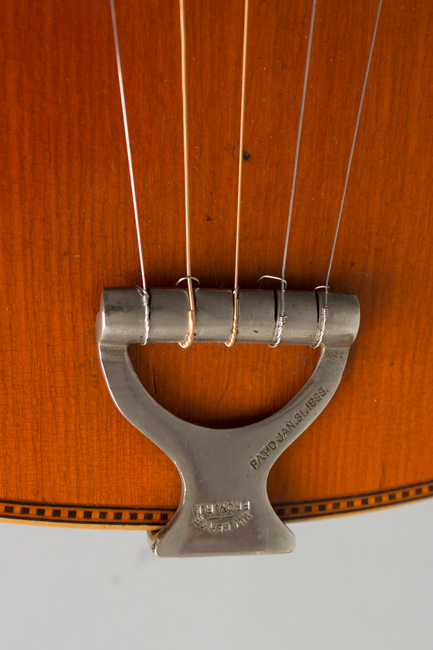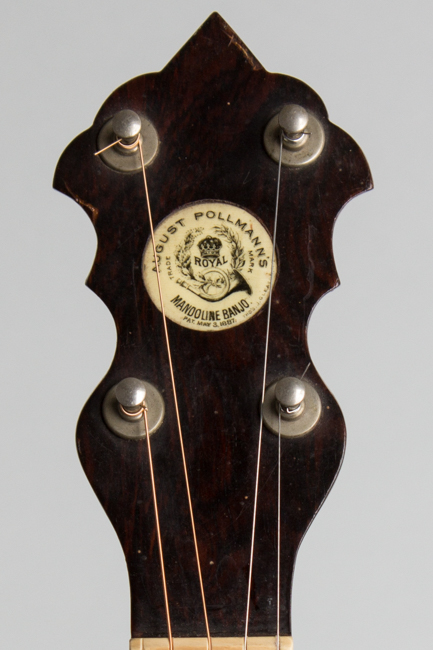August Pollmann Royal Mandolin Banjo (1890s)
This item has been sold.
Item # 9963
Prices subject to change without notice.
August Pollmann Royal Model Mandolin Banjo (1890s), made in USA, natural varnish finish, spruce top, brazilian rosewood back, sides, and fretboard, black gig bag case.
This Pollman Royal Mandolin Banjo is a truly stellar example of one of the more unusual crossbreeding experiments in American Lutherie. The instrument consists of a five-string banjo-style neck mounted on a flat-topped wooden body roughly the size and shape of a flat-back mandola. A product of the late nineteenth century boom in both banjos and mandolins, this hybrid makes a claim to being both at once! Tuned and played like a 5-string banjo, it has a delicate and enchanting sound more like a small guitar or lute.
These are thought to have been made for August Pollman's New York based company by Pehr Anderberg, a Swedish-born luthier who also worked for Bay State in Boston. They are superbly made using very high quality materials and construction details throughout. The solid spruce X-braced top has a mandolin-like pickguard with a floral stylized wood marquetry inlay against a brown inlaid wood background. The top is bound with ladder-pattern wood marquetry as is the soundhole ring. The back and sides of the vaguely pear shaped body are beautifully figured Brazilian rosewood. The varnish finish on the spruce top has a deep amber tone.
A brand on the backbrace reads "Pat. May 3, 1887". The metal trapeze tailpiece reads "WM. GERKE, Prov. R.I., Pat'd Jan. 31. 1888". Five different shaped mother of pearl inlays adorn fretboard. The banjo friction tuners are stamped "pat. May 1888". Inlayed in the headstock is an ivoroid disk with "August Pollman's ROYAL Mandolin Banjo" and the patent date. There is an old owners name written in pencil on the backstrip with a date of 1903.
Beautifully made but somewhat delicate, these Pollmans rarely survive in as fine condition as this one. One was famously used in a prop in noted photographer Alfred Cheney Johnson's studio in the 1920's, gradually sinking into decrepitude as it appears in many of his portraits of the beautiful Ziegfeld girls. This one has survived fully original, playing and sounding excellent, a great instrument for the turn-of-the (last) century banjo enthusiast or anyone looking for a truly unique sound. Overall just a superb example of this delightful oddity, hardly showing its 125 or so years at all.
Overall length is 34 1/8 in. (86.7 cm.), 10 3/8 in. (26.4 cm.) wide at lower bout, and 3 9/16 in. (9 cm.) in depth at side, taken at the end block. Scale length is 23 3/4 in. (584 mm.). Width of nut is 1 5/16 in. (33 mm.).
This is an amazingly clean and playable instrument, especially for being something like 130 years old. There do not appear to be any cracks on the instrument, the original varnish has checked but shows only some minor wear. There are a few chips to the top finish under the bridge. The nut has been replaced but all else appears original. Something of a miraculous survivor of the late 19th century, This Royal Mandoline Banjo plays and sounds great and is housed in a modern gig bag replacing whatever lost canvas or leather case it might have had long ago. Excellent Condition.
This Pollman Royal Mandolin Banjo is a truly stellar example of one of the more unusual crossbreeding experiments in American Lutherie. The instrument consists of a five-string banjo-style neck mounted on a flat-topped wooden body roughly the size and shape of a flat-back mandola. A product of the late nineteenth century boom in both banjos and mandolins, this hybrid makes a claim to being both at once! Tuned and played like a 5-string banjo, it has a delicate and enchanting sound more like a small guitar or lute.
These are thought to have been made for August Pollman's New York based company by Pehr Anderberg, a Swedish-born luthier who also worked for Bay State in Boston. They are superbly made using very high quality materials and construction details throughout. The solid spruce X-braced top has a mandolin-like pickguard with a floral stylized wood marquetry inlay against a brown inlaid wood background. The top is bound with ladder-pattern wood marquetry as is the soundhole ring. The back and sides of the vaguely pear shaped body are beautifully figured Brazilian rosewood. The varnish finish on the spruce top has a deep amber tone.
A brand on the backbrace reads "Pat. May 3, 1887". The metal trapeze tailpiece reads "WM. GERKE, Prov. R.I., Pat'd Jan. 31. 1888". Five different shaped mother of pearl inlays adorn fretboard. The banjo friction tuners are stamped "pat. May 1888". Inlayed in the headstock is an ivoroid disk with "August Pollman's ROYAL Mandolin Banjo" and the patent date. There is an old owners name written in pencil on the backstrip with a date of 1903.
Beautifully made but somewhat delicate, these Pollmans rarely survive in as fine condition as this one. One was famously used in a prop in noted photographer Alfred Cheney Johnson's studio in the 1920's, gradually sinking into decrepitude as it appears in many of his portraits of the beautiful Ziegfeld girls. This one has survived fully original, playing and sounding excellent, a great instrument for the turn-of-the (last) century banjo enthusiast or anyone looking for a truly unique sound. Overall just a superb example of this delightful oddity, hardly showing its 125 or so years at all.
Overall length is 34 1/8 in. (86.7 cm.), 10 3/8 in. (26.4 cm.) wide at lower bout, and 3 9/16 in. (9 cm.) in depth at side, taken at the end block. Scale length is 23 3/4 in. (584 mm.). Width of nut is 1 5/16 in. (33 mm.).
This is an amazingly clean and playable instrument, especially for being something like 130 years old. There do not appear to be any cracks on the instrument, the original varnish has checked but shows only some minor wear. There are a few chips to the top finish under the bridge. The nut has been replaced but all else appears original. Something of a miraculous survivor of the late 19th century, This Royal Mandoline Banjo plays and sounds great and is housed in a modern gig bag replacing whatever lost canvas or leather case it might have had long ago. Excellent Condition.
